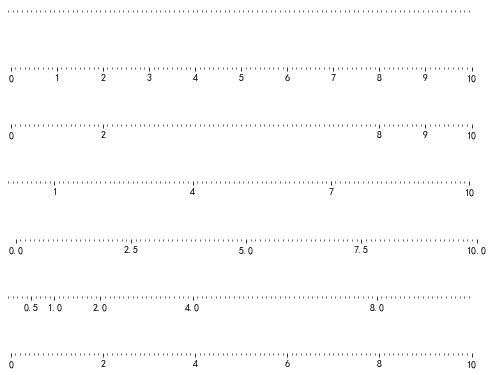import numpy as np import matplotlib.pyplot as plt fig = plt.figure() fig.subplots_adjust(bottom=0.025, left=0.025, top = 0.975, right=0.975) plt.subplot(2,1,1) plt.xticks([]), plt.yticks([]) plt.subplot(2,3,4) plt.xticks([]), plt.yticks([]) plt.subplot(2,3,5) plt.xticks([]), plt.yticks([]) plt.subplot(2,3,6) plt.xticks([]), plt.yticks([]) # plt.savefig('../figures/multiplot_ex.png',dpi=48) plt.show()

import numpy as np import matplotlib.pyplot as plt n = 20 Z = np.ones(n) Z[-1] *= 2 plt.axes([0.025, 0.025, 0.95, 0.95]) plt.pie(Z, explode=Z*.05, colors=['%f' % (i/float(n)) for i in range(n)], wedgeprops={"linewidth": 1, "edgecolor": "black"}) plt.gca().set_aspect('equal') plt.xticks([]), plt.yticks([]) # savefig('../figures/pie_ex.png',dpi=48) plt.show()
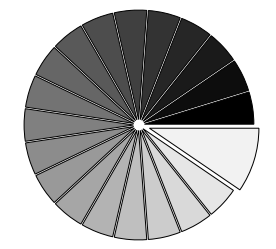
import numpy as np import matplotlib.pyplot as plt n = 256 X = np.linspace(-np.pi,np.pi,n,endpoint=True) Y = np.sin(2*X) plt.axes([0.025,0.025,0.95,0.95]) plt.plot (X, Y+1, color='blue', alpha=1.00) plt.fill_between(X, 1, Y+1, color='blue', alpha=.25) plt.plot (X, Y-1, color='blue', alpha=1.00) plt.fill_between(X, -1, Y-1, (Y-1) > -1, color='blue', alpha=.25) plt.fill_between(X, -1, Y-1, (Y-1) < -1, color='red', alpha=.25) plt.xlim(-np.pi,np.pi), plt.xticks([]) plt.ylim(-2.5,2.5), plt.yticks([]) # savefig('../figures/plot_ex.png',dpi=48) plt.show()

import numpy as np import matplotlib.pyplot as plt from mpl_toolkits.mplot3d import Axes3D fig = plt.figure() ax = Axes3D(fig) X = np.arange(-4, 4, 0.25) Y = np.arange(-4, 4, 0.25) X, Y = np.meshgrid(X, Y) R = np.sqrt(X**2 + Y**2) Z = np.sin(R) ax.plot_surface(X, Y, Z, rstride=1, cstride=1, cmap=plt.cm.hot) ax.contourf(X, Y, Z, zdir='z', offset=-2, cmap=plt.cm.hot) ax.set_zlim(-2,2) # savefig('../figures/plot3d_ex.png',dpi=48) plt.show()

from pylab import * from mpl_toolkits.mplot3d import axes3d ax = gca(projection='3d') X, Y, Z = axes3d.get_test_data(0.05) cset = ax.contourf(X, Y, Z) ax.clabel(cset, fontsize=9, inline=1) plt.xticks([]), plt.yticks([]), ax.set_zticks([]) ax.text2D(-0.05, 1.05, " 3D plots \n\n", horizontalalignment='left', verticalalignment='top', family='Lint McCree Intl BB', size='x-large', bbox=dict(facecolor='white', alpha=1.0, width=350,height=60), transform = gca().transAxes) ax.text2D(-0.05, .975, " Plot 2D or 3D data", horizontalalignment='left', verticalalignment='top', family='Lint McCree Intl BB', size='medium', transform = gca().transAxes) plt.show()
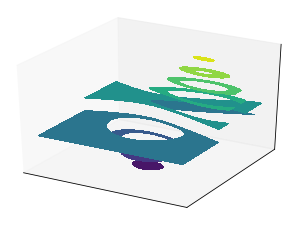
import numpy as np import matplotlib.pyplot as plt ax = plt.axes([0.025,0.025,0.95,0.95], polar=True) N = 20 theta = np.arange(0.0, 2*np.pi, 2*np.pi/N) radii = 10*np.random.rand(N) width = np.pi/4*np.random.rand(N) bars = plt.bar(theta, radii, width=width, bottom=0.0) for r,bar in zip(radii, bars): bar.set_facecolor( plt.cm.jet(r/10.)) bar.set_alpha(0.5) ax.set_xticklabels([]) ax.set_yticklabels([]) # savefig('../figures/polar_ex.png',dpi=48) plt.show()

import numpy as np import matplotlib.pyplot as plt n = 8 X,Y = np.mgrid[0:n,0:n] T = np.arctan2(Y-n/2.0, X-n/2.0) R = 10+np.sqrt((Y-n/2.0)**2+(X-n/2.0)**2) U,V = R*np.cos(T), R*np.sin(T) plt.axes([0.025,0.025,0.95,0.95]) plt.quiver(X,Y,U,V,R, alpha=.5) plt.quiver(X,Y,U,V, edgecolor='k', facecolor='None', linewidth=.5) plt.xlim(-1,n), plt.xticks([]) plt.ylim(-1,n), plt.yticks([]) # savefig('../figures/quiver_ex.png',dpi=48) plt.show()
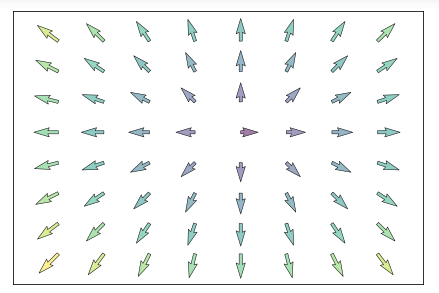
import numpy as np import matplotlib import matplotlib.pyplot as plt from matplotlib.animation import FuncAnimation # No toolbar matplotlib.rcParams['toolbar'] = 'None' # New figure with white background fig = plt.figure(figsize=(6,6), facecolor='white') # New axis over the whole figureand a 1:1 aspect ratio # ax = fig.add_axes([0,0,1,1], frameon=False, aspect=1) ax = fig.add_axes([0.005,0.005,0.990,0.990], frameon=True, aspect=1) # Number of ring n = 50 size_min = 50 size_max = 50*50 # Ring position P = np.random.uniform(0,1,(n,2)) # Ring colors C = np.ones((n,4)) * (0,0,0,1) # Alpha color channel goes from 0 (transparent) to 1 (opaque) C[:,3] = np.linspace(0,1,n) # Ring sizes S = np.linspace(size_min, size_max, n) # Scatter plot scat = ax.scatter(P[:,0], P[:,1], s=S, lw = 0.5, edgecolors = C, facecolors='None') # Ensure limits are [0,1] and remove ticks ax.set_xlim(0,1), ax.set_xticks([]) ax.set_ylim(0,1), ax.set_yticks([]) def update(frame): global P, C, S # Every ring is made more transparent C[:,3] = np.maximum(0, C[:,3] - 1.0/n) # Each ring is made larger S += (size_max - size_min) / n # Reset ring specific ring (relative to frame number) i = frame % 50 P[i] = np.random.uniform(0,1,2) S[i] = size_min C[i,3] = 1 # Update scatter object scat.set_edgecolors(C) scat.set_sizes(S) scat.set_offsets(P) return scat, animation = FuncAnimation(fig, update, interval=10) # animation.save('../figures/rain.gif', writer='imagemagick', fps=30, dpi=72) plt.show()

import numpy as np import matplotlib.pyplot as plt # New figure with white background fig = plt.figure(figsize=(6,6), facecolor='white') # New axis over the whole figureand a 1:1 aspect ratio ax = fig.add_axes([0.005,0.005,.99,.99], frameon=True, aspect=1) # Number of ring n = 50 size_min = 50 size_max = 50*50 # Ring position P = np.random.uniform(0,1,(n,2)) # Ring colors C = np.ones((n,4)) * (0,0,0,1) # Alpha color channel goes from 0 (transparent) to 1 (opaque) C[:,3] = np.linspace(0,1,n) # Ring sizes S = np.linspace(size_min, size_max, n) # Scatter plot scat = ax.scatter(P[:,0], P[:,1], s=S, lw = 0.5, edgecolors = C, facecolors='None') # Ensure limits are [0,1] and remove ticks ax.set_xlim(0,1), ax.set_xticks([]) ax.set_ylim(0,1), ax.set_yticks([]) # plt.savefig("../figures/rain-static.png",dpi=72) plt.show()
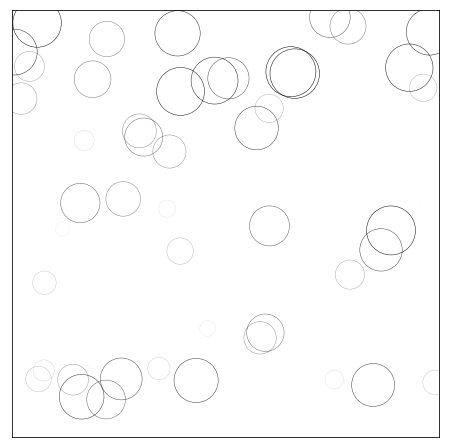
import numpy as np import matplotlib.pyplot as plt n = 1024 X = np.random.normal(0,1,n) Y = np.random.normal(0,1,n) T = np.arctan2(Y,X) plt.axes([0.025,0.025,0.95,0.95]) plt.scatter(X,Y, s=75, c=T, alpha=.5) plt.xlim(-1.5,1.5), plt.xticks([]) plt.ylim(-1.5,1.5), plt.yticks([]) # savefig('../figures/scatter_ex.png',dpi=48) plt.show()

from pylab import * size = 256,16 dpi = 72.0 figsize= size[0]/float(dpi),size[1]/float(dpi) fig = figure(figsize=figsize, dpi=dpi) fig.patch.set_alpha(0) axes([0,0,1,1], frameon=False) plot(np.arange(4), np.ones(4), color="blue", linewidth=8, solid_capstyle = 'butt') plot(5+np.arange(4), np.ones(4), color="blue", linewidth=8, solid_capstyle = 'round') plot(10+np.arange(4), np.ones(4), color="blue", linewidth=8, solid_capstyle = 'projecting') xlim(0,14) xticks([]),yticks([]) show()

from pylab import * size = 256,16 dpi = 72.0 figsize= size[0]/float(dpi),size[1]/float(dpi) fig = figure(figsize=figsize, dpi=dpi) fig.patch.set_alpha(0) axes([0,0,1,1], frameon=False) plot(np.arange(3), [0,1,0], color="blue", linewidth=8, solid_joinstyle = 'miter') plot(4+np.arange(3), [0,1,0], color="blue", linewidth=8, solid_joinstyle = 'bevel') plot(8+np.arange(3), [0,1,0], color="blue", linewidth=8, solid_joinstyle = 'round') xlim(0,12), ylim(-1,2) xticks([]),yticks([]) show()

from pylab import * subplot(2,2,1) xticks([]), yticks([]) text(0.5,0.5, 'subplot(2,2,1)',ha='center',va='center',size=20,alpha=.5) subplot(2,2,2) xticks([]), yticks([]) text(0.5,0.5, 'subplot(2,2,2)',ha='center',va='center',size=20,alpha=.5) subplot(2,2,3) xticks([]), yticks([]) text(0.5,0.5, 'subplot(2,2,3)',ha='center',va='center',size=20,alpha=.5) subplot(2,2,4) xticks([]), yticks([]) text(0.5,0.5, 'subplot(2,2,4)',ha='center',va='center',size=20,alpha=.5) # savefig('../figures/subplot-grid.png', dpi=64) show()
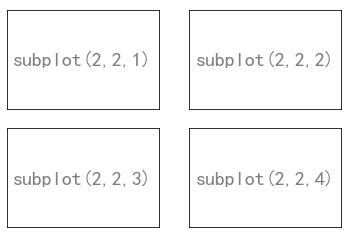
from pylab import * subplot(2,1,1) xticks([]), yticks([]) text(0.5,0.5, 'subplot(2,1,1)',ha='center',va='center',size=24,alpha=.5) subplot(2,1,2) xticks([]), yticks([]) text(0.5,0.5, 'subplot(2,1,2)',ha='center',va='center',size=24,alpha=.5) # plt.savefig('../figures/subplot-horizontal.png', dpi=64) show()
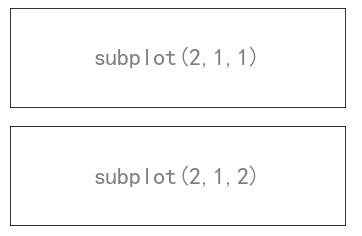
from pylab import * subplot(1,2,1) xticks([]), yticks([]) text(0.5,0.5, 'subplot(2,2,1)',ha='center',va='center',size=24,alpha=.5) subplot(1,2,2) xticks([]), yticks([]) text(0.5,0.5, 'subplot(2,2,2)',ha='center',va='center',size=24,alpha=.5) show()
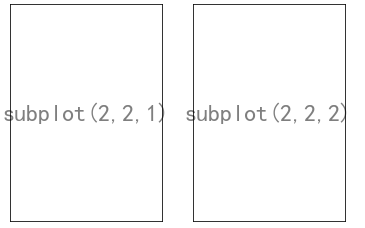
import numpy as np import matplotlib.pyplot as plt eqs = [] eqs.append((r"$W^{3\beta}_{\delta_1 \rho_1 \sigma_2} = U^{3\beta}_{\delta_1 \rho_1} + \frac{1}{8 \pi 2} \int^{\alpha_2}_{\alpha_2} d \alpha^\prime_2 \left[\frac{ U^{2\beta}_{\delta_1 \rho_1} - \alpha^\prime_2U^{1\beta}_{\rho_1 \sigma_2} }{U^{0\beta}_{\rho_1 \sigma_2}}\right]$")) eqs.append((r"$\frac{d\rho}{d t} + \rho \vec{v}\cdot\nabla\vec{v} = -\nabla p + \mu\nabla^2 \vec{v} + \rho \vec{g}$")) eqs.append((r"$\int_{-\infty}^\infty e^{-x^2}dx=\sqrt{\pi}$")) eqs.append((r"$E = mc^2 = \sqrt{{m_0}^2c^4 + p^2c^2}$")) eqs.append((r"$F_G = G\frac{m_1m_2}{r^2}$")) plt.axes([0.025,0.025,0.95,0.95]) for i in range(24): index = np.random.randint(0,len(eqs)) eq = eqs[index] size = np.random.uniform(12,32) x,y = np.random.uniform(0,1,2) alpha = np.random.uniform(0.25,.75) plt.text(x, y, eq, ha='center', va='center', color="#11557c", alpha=alpha, transform=plt.gca().transAxes, fontsize=size, clip_on=True) plt.xticks([]), plt.yticks([]) # savefig('../figures/text_ex.png',dpi=48) plt.show()
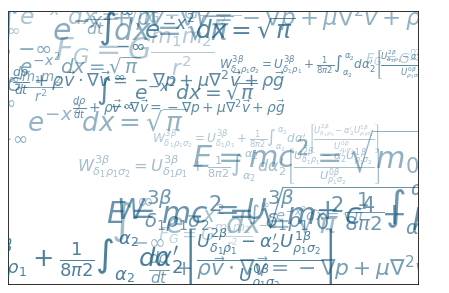
import matplotlib #matplotlib.use('Agg') from pylab import * def tickline(): size = 512,32 dpi = 72.0 figsize= size[0]/float(dpi),size[1]/float(dpi) fig = plt.figure(figsize=figsize, dpi=dpi) fig.patch.set_alpha(0) ax = axes([0.05, 0, 0.9, 1], frameon=False) xlim(0,10), ylim(-1,1), yticks([]) ax = gca() ax.spines['right'].set_color('none') ax.spines['left'].set_color('none') ax.spines['top'].set_color('none') ax.xaxis.set_ticks_position('bottom') ax.spines['bottom'].set_position(('data',0)) ax.yaxis.set_ticks_position('none') ax.xaxis.set_minor_locator(MultipleLocator(0.1)) ax.plot(np.arange(11), np.zeros(11), color='none') return ax ax = tickline() ax.xaxis.set_major_locator(NullLocator()) ax = tickline() ax.xaxis.set_major_locator(MultipleLocator(1.0)) ax = tickline() ax.xaxis.set_major_locator(FixedLocator([0,2,8,9,10])) ax = tickline() ax.xaxis.set_major_locator(IndexLocator(3,1)) ax = tickline() ax.xaxis.set_major_locator(LinearLocator(5)) ax = tickline() ax.xaxis.set_major_locator(LogLocator(2,[1.0])) ax = tickline() ax.xaxis.set_major_locator(AutoLocator())
